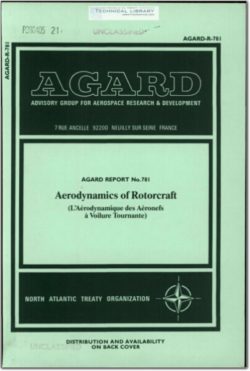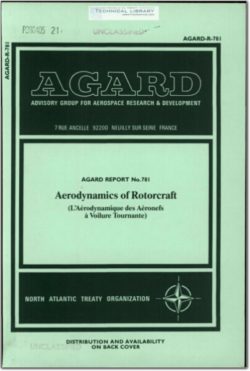AGARD-R-781

- Version
- 563 Downloads
- 117.98 MB File Size
- 1 File Count
- April 12, 2016 Create Date
- April 12, 2016 Last Updated
Aerodynamics of Rotorcraft

The concept of flying, including the ability to rise and descend vertically at will. is one of
mankind's oldest dreams. Many birds can hover for short periods. and the hummingbird seems able to do
so for as long as it likes. Many insects can hover as well: bees, dragonflies, and mosquitoes
(unfortunately) come to mind as examples. So man's dream is hardly surprising.
Long ago. the date now lost but certainly before the birth of Christ, the ancient Chinese
invented a toy consisting of feathers attached to a stick. that would fly briefly when spun between
the hands and released like a top (Figure 1). The modern version. a wooden propeller on a stick. is
still a popular toy. The earliest notion of a machine designed to carry men vertically upward is
usually credited to Leonardo daVinci who drew a sketch (Figure 2) of a supposedly man-powered aircraft
in 1&85. By means of a mechanism not clearly defined. a helical surface was rotated so that the
machine would advance upward through the air like a screw. Leonardo possibly had more confidence that
his machine would rise successfully than he had in its ability to descend safely. for in the same year
he invented another device that would allow safe vertical descent (Figure 3). We call them parachutes
now, and the ones he drew were surprisingly close to modern practice. On the other hand, we now know
that his helicopter design was a long way from being feasible. Even so, it was an inspiration to many
who followed.
The development of a truly successful helicopter took many years by many experimenters in
numerous countries. A complete listing would be a lengthy undertaking; the following is certainly
incomplete. Probably the first model helicopter to fly on its own power other than the kinetic
energy of its blades was one demonstrated by the Frenchmen Launoy and Bienvenue in 1784 (Figure 4).
This was essentially a counterrotating coaxial Chinese top, powered by the elastic energy of a drawn
bow through the bowstring wound around a central shaft. It is reported that Mikhail Lomonosov of
Russia also flew a model at about the same time.
In the 1800's, the number of people experimenting with helicopters increased. Some of the
noteworthy contributors include Sir George Cayley of England, Alphonse Penaud of France. Enrico
Forlanini of Italy, and Thomas Edison of the United States of America. Viscount Gustave dePonton
d'Amecourt of France should also be mentioned. He flew a number of models, and also put together the
Greek words "heliko" and "pteron", meaning "spiral" and "wing" respectively. Thus he coined a lasting
name for his mechanisms; he called them "helicoptéres".
| File | Action |
|---|---|
| AGARD-R-781 Aerodynamics of Rotorcraft.pdf | Download |
Comment On This Post